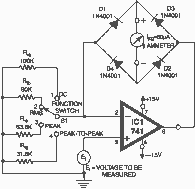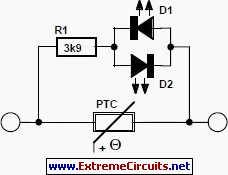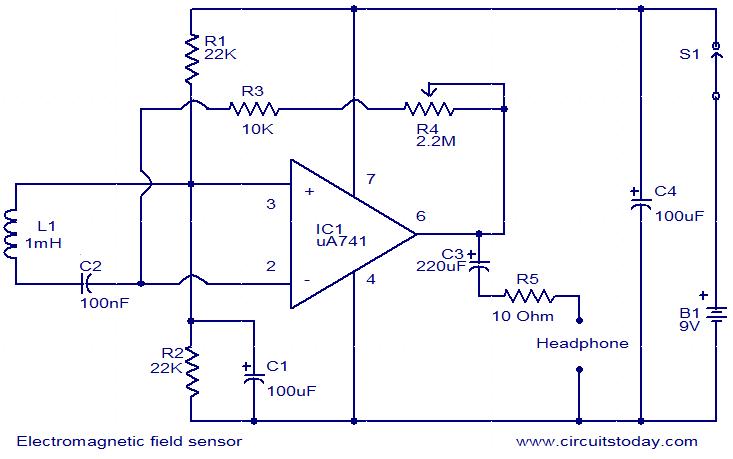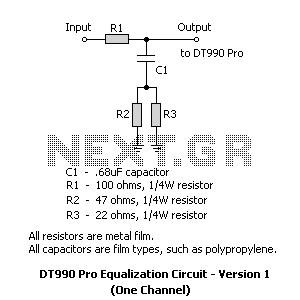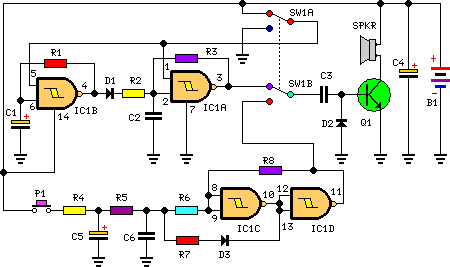
BC548 Heat Sensor Diagram Circuit
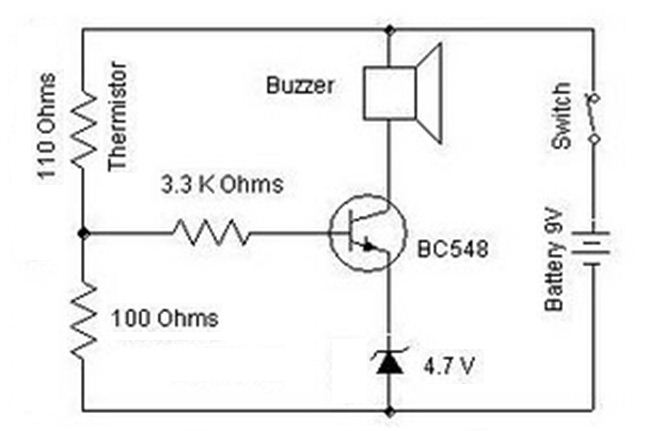
A heat sensor circuit can be utilized to control any device using a heat sensor. In this circuit, a thermistor and a resistor are connected in series, forming a potential divider circuit. The thermistor is of the Negative Temperature Coefficient (NTC) type, meaning that as the room temperature increases, its resistance decreases correspondingly, allowing more current to flow through both the resistor and the thermistor. The resistance value of the thermistor is initially 110 ohms. If the resistance decreases to 90 ohms due to heating, the voltage across one resistor in the voltage divider circuit is determined by the ratio of that resistor's value to the total resistance of the series combination. This illustrates the concept of a voltage divider. The final output voltage from the voltage divider circuit is then applied to an NPN transistor (BC548) through a base resistor of 3.3 kΩ. In this configuration, the emitter resistor is substituted with a Zener diode, which maintains the emitter voltage at 4.7 volts. This voltage is used for comparison purposes. The transistor will conduct when the base voltage exceeds the emitter voltage, specifically when it receives more than 4.7 volts at the base. Once the transistor conducts, the circuit is completed, activating a buzzer that produces sound.
The heat sensor circuit operates on the principle of temperature-dependent resistance changes in the thermistor. The NTC thermistor is critical in this design, as it allows for the detection of temperature variations. As the ambient temperature rises, the decrease in thermistor resistance leads to an increase in current through the potential divider, resulting in a higher voltage at the junction of the thermistor and resistor. This voltage is crucial for controlling the transistor.
The BC548 NPN transistor serves as a switching element in the circuit. The base resistor of 3.3 kΩ limits the current into the base of the transistor, ensuring that it operates within safe parameters. The use of a Zener diode for the emitter stabilizes the voltage, providing a reliable reference for the base-emitter junction. When the input voltage at the base exceeds 4.7 volts, the transistor enters saturation, allowing current to flow from the collector to the emitter, thus activating the buzzer.
This circuit is versatile and can be adapted for various applications, such as temperature alarms, automatic fans, or other devices that require temperature monitoring and control. The design is straightforward and can be implemented with minimal components, making it suitable for educational projects or practical applications in temperature-sensitive environments.Heat sensor circuit can be used to control any device using heat sensor. In this circuit a thermistor and a resistance is connected in series. This arrangement makes a potential divider circuit. Here the thermistor is Negative Temperature Coefficient type. So when the room temperature is increased its resistance decreases simultaneously and more c urrent flows through the resistor and the thermistor. We find more voltage at the junction of the resistor and the thermistor. Our thermistor resistance value is 110 ohms. Suppose the resistance value becomes 90 ohms after heating the 110 ohms thermistor. Then the voltage across one resistor of the voltage divider circuit equals the ratio of that resistor`s value and the sum of resistances of the voltage across the series combination. This is the concept of voltage divider. The final output voltage of the voltage divider circuit is now applied to the npn transistor (BC548) through the base resistor (3.
3K ohms). Here the emitter resistor is replaced with a zener diode. Emitter voltage is maintained at 4. 7volt with the help of zener diode. This voltage is used to compare voltage. Transistor conducts when base voltage is greater than the emitter voltage. Transistor conducts if it gets more than 4. 7volt of base voltage. Then the circuit is completed through buzzer and it gives sound. 🔗 External reference
The heat sensor circuit operates on the principle of temperature-dependent resistance changes in the thermistor. The NTC thermistor is critical in this design, as it allows for the detection of temperature variations. As the ambient temperature rises, the decrease in thermistor resistance leads to an increase in current through the potential divider, resulting in a higher voltage at the junction of the thermistor and resistor. This voltage is crucial for controlling the transistor.
The BC548 NPN transistor serves as a switching element in the circuit. The base resistor of 3.3 kΩ limits the current into the base of the transistor, ensuring that it operates within safe parameters. The use of a Zener diode for the emitter stabilizes the voltage, providing a reliable reference for the base-emitter junction. When the input voltage at the base exceeds 4.7 volts, the transistor enters saturation, allowing current to flow from the collector to the emitter, thus activating the buzzer.
This circuit is versatile and can be adapted for various applications, such as temperature alarms, automatic fans, or other devices that require temperature monitoring and control. The design is straightforward and can be implemented with minimal components, making it suitable for educational projects or practical applications in temperature-sensitive environments.Heat sensor circuit can be used to control any device using heat sensor. In this circuit a thermistor and a resistance is connected in series. This arrangement makes a potential divider circuit. Here the thermistor is Negative Temperature Coefficient type. So when the room temperature is increased its resistance decreases simultaneously and more c urrent flows through the resistor and the thermistor. We find more voltage at the junction of the resistor and the thermistor. Our thermistor resistance value is 110 ohms. Suppose the resistance value becomes 90 ohms after heating the 110 ohms thermistor. Then the voltage across one resistor of the voltage divider circuit equals the ratio of that resistor`s value and the sum of resistances of the voltage across the series combination. This is the concept of voltage divider. The final output voltage of the voltage divider circuit is now applied to the npn transistor (BC548) through the base resistor (3.
3K ohms). Here the emitter resistor is replaced with a zener diode. Emitter voltage is maintained at 4. 7volt with the help of zener diode. This voltage is used to compare voltage. Transistor conducts when base voltage is greater than the emitter voltage. Transistor conducts if it gets more than 4. 7volt of base voltage. Then the circuit is completed through buzzer and it gives sound. 🔗 External reference
